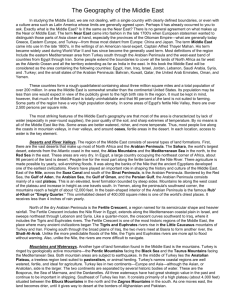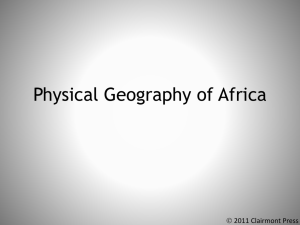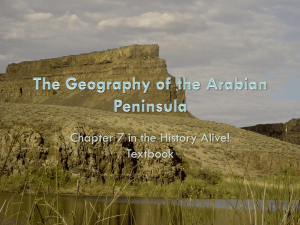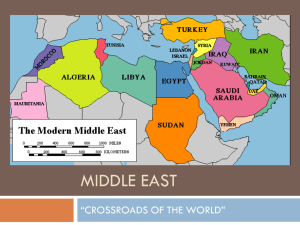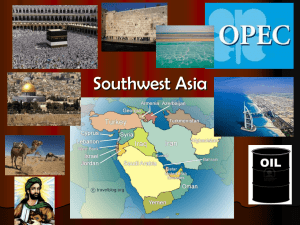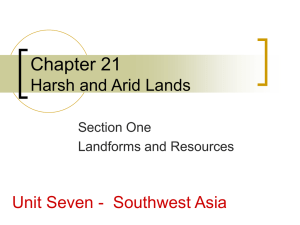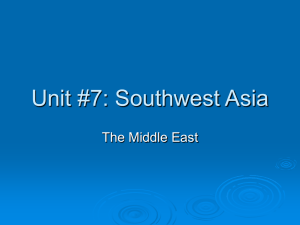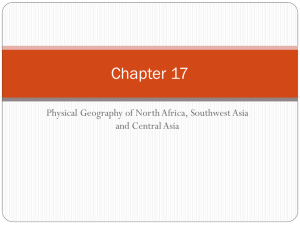Exploring Geography of the Middle East
advertisement
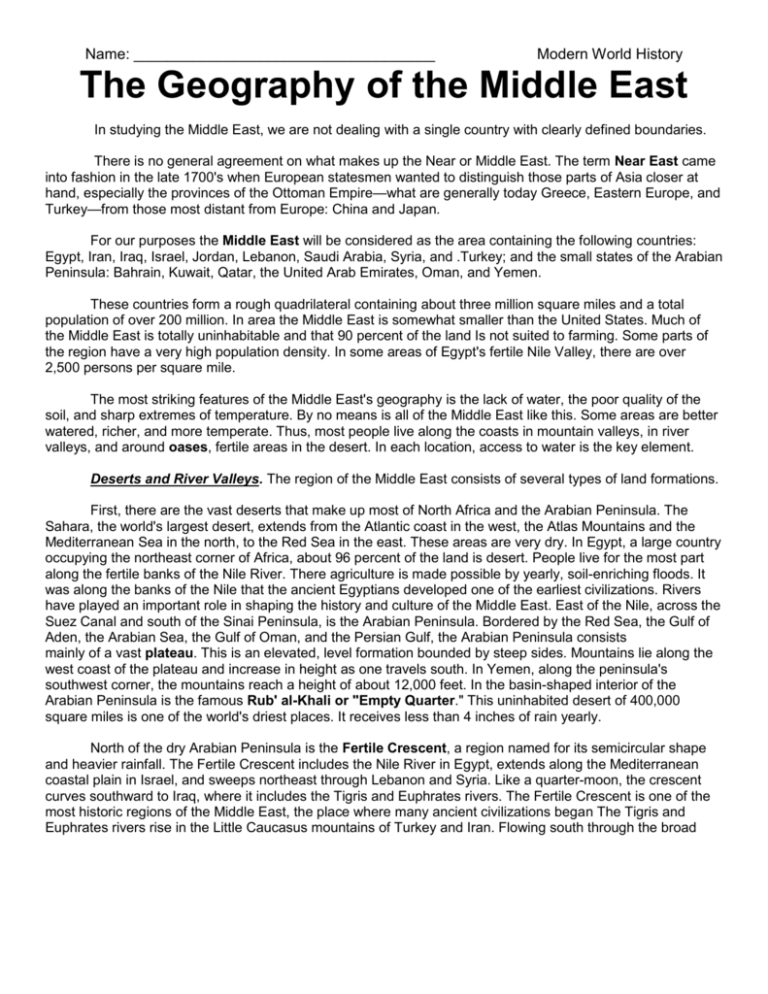
Name: ____________________________________ Modern World History The Geography of the Middle East In studying the Middle East, we are not dealing with a single country with clearly defined boundaries. There is no general agreement on what makes up the Near or Middle East. The term Near East came into fashion in the late 1700's when European statesmen wanted to distinguish those parts of Asia closer at hand, especially the provinces of the Ottoman Empire—what are generally today Greece, Eastern Europe, and Turkey—from those most distant from Europe: China and Japan. For our purposes the Middle East will be considered as the area containing the following countries: Egypt, Iran, Iraq, Israel, Jordan, Lebanon, Saudi Arabia, Syria, and .Turkey; and the small states of the Arabian Peninsula: Bahrain, Kuwait, Qatar, the United Arab Emirates, Oman, and Yemen. These countries form a rough quadrilateral containing about three million square miles and a total population of over 200 million. In area the Middle East is somewhat smaller than the United States. Much of the Middle East is totally uninhabitable and that 90 percent of the land Is not suited to farming. Some parts of the region have a very high population density. In some areas of Egypt's fertile Nile Valley, there are over 2,500 persons per square mile. The most striking features of the Middle East's geography is the lack of water, the poor quality of the soil, and sharp extremes of temperature. By no means is all of the Middle East like this. Some areas are better watered, richer, and more temperate. Thus, most people live along the coasts in mountain valleys, in river valleys, and around oases, fertile areas in the desert. In each location, access to water is the key element. Deserts and River Valleys. The region of the Middle East consists of several types of land formations. First, there are the vast deserts that make up most of North Africa and the Arabian Peninsula. The Sahara, the world's largest desert, extends from the Atlantic coast in the west, the Atlas Mountains and the Mediterranean Sea in the north, to the Red Sea in the east. These areas are very dry. In Egypt, a large country occupying the northeast corner of Africa, about 96 percent of the land is desert. People live for the most part along the fertile banks of the Nile River. There agriculture is made possible by yearly, soil-enriching floods. It was along the banks of the Nile that the ancient Egyptians developed one of the earliest civilizations. Rivers have played an important role in shaping the history and culture of the Middle East. East of the Nile, across the Suez Canal and south of the Sinai Peninsula, is the Arabian Peninsula. Bordered by the Red Sea, the Gulf of Aden, the Arabian Sea, the Gulf of Oman, and the Persian Gulf, the Arabian Peninsula consists mainly of a vast plateau. This is an elevated, level formation bounded by steep sides. Mountains lie along the west coast of the plateau and increase in height as one travels south. In Yemen, along the peninsula's southwest corner, the mountains reach a height of about 12,000 feet. In the basin-shaped interior of the Arabian Peninsula is the famous Rub' al-Khali or "Empty Quarter." This uninhabited desert of 400,000 square miles is one of the world's driest places. It receives less than 4 inches of rain yearly. North of the dry Arabian Peninsula is the Fertile Crescent, a region named for its semicircular shape and heavier rainfall. The Fertile Crescent includes the Nile River in Egypt, extends along the Mediterranean coastal plain in Israel, and sweeps northeast through Lebanon and Syria. Like a quarter-moon, the crescent curves southward to Iraq, where it includes the Tigris and Euphrates rivers. The Fertile Crescent is one of the most historic regions of the Middle East, the place where many ancient civilizations began The Tigris and Euphrates rivers rise in the Little Caucasus mountains of Turkey and Iran. Flowing south through the broad plains of Iraq, the two rivers meet at Basra to form another river, the Shatt-AI-Arab. Unlike the more predictable floods of the Nile, the Tigris and Euphrates rivers are more apt to flood without warning. Also, unlike the Nile, the rivers are more difficult to navigate. Mountains and Waterways. Another type of land formation found in the Middle East is the mountains. Turkey is ringed by geologically active mountains—the Pontic Mountains facing the Black Sea and the Taurus Mountains facing the Mediterranean Sea. Both mountain areas are subject to earthquakes. In the middle of Turkey lies the Anatolian Plateau, a treeless region best suited to pastoralism, or animal herding. Turkey's narrow coastal regions are well watered, fertile, and ideal for agriculture. Turkey lies in two continents—Europe and Asia—although the Asian, or Anatolian, side is the larger. The two continents are separated by several historic bodies of water. These are the Bosporus, the Sea of Marmara, and the Dardanelles. All three waterways have had great strategic value in the past and continue to be important in shipping. Southeast of Turkey lies Iran. It consists primarily of a high plateau (about 4,000 feet) situated between the Elburz Mountains in the north and the Zagros Mountains in the south. As one moves east, the land becomes drier, until it gives way to desert at the borders of Afghanistan and Pakistan. Limited Rainfall. Few places in the Middle East get the 40 to 50 inches of rain each year that falls in the eastern United States. This is due to several factors. Moisture-laden winds from the Mediterranean, Black, and Caspian Seas drop their rain on the seaward side of the upland mountain slopes. Consequently, the inland areas get very little rainfall. The further inland one goes from the mountain slopes that ring the Mediterranean, the less water one finds. The southern side of the Arabian Peninsula receives rainfall from summer monsoons blowing from the Indian Ocean. Monsoons are winds that change direction with the seasons. Winter monsoons are generally dry and summer monsoons are very wet. In Yemen, the amount of rainfall is sufficient to grow coffee plants. (It was through the Yemeni port of Mocha that coffee achieved worldwide popularity as a beverage.) Almost everywhere else in the region rain falls during the winter months when the westerly winds bring moisture to the land. However, the amount and length of rainfall varies considerably from year to year. For example, one year's rainfall may be limited to two or three cloudbursts. These sudden, intense rains often produce floods that erode, or wear away, the soil rather than increase its fertility. Irrigation. Because of the dry soil and meager rainfall, non-irrigated farming is possible only in small areas of Iran, Turkey, Lebanon, Syria, Jordan, and Israel. Wide-scale agriculture is possible only by means of irrigation. It is limited to the river valleys of the Nile and the Tigris and Euphrates. In Iran and Oman underground canals carry water from mountain streams to the plains. However, steady irrigation can raise problems. Ground water can be completely used up. Also, the soil may become useless due to high salt content. When the water table (the portion of the ground completely saturated with water) is near the surface of the ground, salt that exists naturally in the soil is drawn upward with the water. Eventually, the amount of salt left near the surface after evaporation will spoil the soil, making it unfit for agriculture. Many acres of otherwise good farmland have had to be abandoned because of this problem. Climate Zones. Most areas of the Middle East generally have hot, dry summers and fairly long winters with some rain. Snow is common at higher elevations. Therefore, temperature ranges may be extreme. In most regions, spring and autumn are brief seasons. During the summer, hot, dusty winds blow inland from the south and southeast. They add to the agricultural problems by blowing away layers of top soil. In the inland plateaus of Iran and Anatolia, winter temperatures fall below freezing and summer temperatures can rise as high as 100°F or more. Rainfall is between 10 to 20 inches. Along the coasts and the Fertile Crescent, rainfall increases up to 40 inches in Beirut, the capital of Lebanon. On the other side of the mountain ranges, Damascus, the capital of Syria, gets only ten inches of rainfall each year. The same contrast holds true for Beersheba in Israel and Amman, the capital of Jordan. Along the Mediterranean coast, however, temperatures are very much like those of southern California. Moving south into the desert it gets even drier. Even along the coast, rainfall averages only ten inches a year. Although rain may not fall, the air may still be humid because of the closeness of the sea. This, combined with high temperatures, can make for a very uncomfortable environment. The contrast in this region is not between coastline and interior, but between desert and river valley. As you have read, rivers have played an important role in the growth of civilization in the Middle East. Egypt is "the gift of the Nile" as Herodotus, the ancient Creek historian wrote. Summers are hot and dry; winters have little rainfall. Cairo, Egypt's capital, has an average yearly rainfall of eight inches. Baghdad, the capital of Iraq, lies between the Tigris and Euphrates rivers. Its annual rainfall, at ten inches, makes it, too, dependent on its rivers. ECONOMICS Given the land formations, availability of water, and climate found in the Middle East, arable land, or land suitable for farming, is severe limited. In fact, only about seven percent of all the land in the Middle East has expanded on a larger, more commercial scale. In oases and the marshlands of Iraq dates are grown for both local consumption and export. Crops like barley, wheat, lentils, and chickpeas are native to the Middle East and are grown wherever possible. Agricultural Products. It was probably in the river valleys of the Middle East that people first cultivated wild grain. Today wheat and barley are the chief crops grown In the region. Other grains cultivated are corn, rye, and rice, a staple of the Middle Eastern diet as it is throughout Asia. Still, the peoples of the Middle East do not always grow enough food for their needs and In some areas must import large amounts of grain. Several Middle Eastern countries still receive wheat and other foodstuffs from the United States as part of Its foreign aid program. Turkey, Syria, and Lebanon are the chief producers of olives. Olive oil is important In the diet of Middle Eastern peoples and Is also a major item for export. The oranges of Turkey and especially of the eastern Mediterranean and Aegean coasts are world famous. Israel's citrus fruits, one of its largest export Items, are sold in many Western European countries. Dates are another leading crop with most of the world's imports coming from Iraq. The date is far more than a basic food In the Middle East. Ground-up date pits serve as animal fodder. The fibers of the date palm are used to make rope, and the wood of the trunk Is used for fuel and timber. Among other fruits of the region are the peaches, pears, and apples of the highlands of Lebanon, the apricots and melons of Iran, and the figs of Turkey. Grapes for the production of wine and raisins are grown throughout the area. Since most of the population is Muslim and prohibited from drinking alcoholic beverages, much of the wine, as well as the grapes for wine production, are exported. Almonds, walnuts, pistachios, and hazelnuts are also valuable exports for the area. Coffee, once an important Middle Eastern product, is no longer a major crop. The famous mocha coffee got its name from the ancient South Arabian coffee-exporting city of Mocha, in Yemen. Tobacco is also grown in small quantities, and some Turkish tobacco is used In American cigarettes. Cotton is the leading industrial crop In the region. Egyptian long-staple cotton is a superior variety, which Is used for the production of fine cloth. Cotton ranks among Egypt's important exports, and a poor crop causes the country to suffer a severe economic setback. Other Middle Eastern countries, such as Turkey, Syria, Iraq, Iran, and Israel, have been raising cotton in recent years. They now grow enough to produce their own raw material for textile manufacture, an important industry In developing nations. Some Popular Foods. There are great varieties of dishes and regional foods in the Middle East. Despite this fact, the food reflects common geographic and cultural factors. The basic foods of the Middle East are unleavened, or yeast-less, bread, and mutton, rice, vegetables, and fruit in season. Cheeses, yogurt, and goat milk are popular. Sesame or olive oil, lemon juice, garlic, tomatoes, and onions are the basic flavoring agents. Despite the limitations on agriculture and herding, Middle Easterners enjoy a healthful diet and tasty dishes. Breakfast, for example, consists of bread, salty white goat cheese, black and green olives, and labnah. (Labnah is a thick cream cheese made by draining yogurt through cheesecloth and drizzling it with olive oil.) Pieces of the bread are ripped off and used to scoop up the separate foods. The beverage is usually Turkish coffee or sweet tea. In Egypt, fava beans are a popular breakfast dish. They are slowly simmered and then served with olive oil, lemon juice, and garlic. Lentils are often served with the beans. Israeli breakfasts are hearty as well. They consist of bread, cheese, tomato and cucumber salad, frequently served with eggs, plus fruit or juice and coffee or tea. Of course, not everyone eats like this every day. But it is interesting to compare the Middle Eastern breakfast of cheese, vegetables, and bread with the American breakfast of pancakes, eggs, or cereal and milk, plus toast, orange juice, and sometimes coffee. Favorite dishes at other meals are kibbe (ground lamb with cracked wheat served in a variety of ways), stuffed vegetables (zucchini, tomatoes, eggplant, or green peppers), and hummus (ground chickpeas flavored with sesame seed oil, lemon juice, and garlic), which is eaten as a dip with flat pita bread. Fruits include grapes, melons, pomegranates, oranges, lemons, dates, and figs. Fruits associated with a more temperate climate, like apples, pears, and cherries, are available but in small quantities. They are associated with areas of higher elevation, where they are local specialties. The apples of Lebanon and the pears of Ankara are two examples. The classic feast of the nomads of the Arabian Peninsula who live off their herds is a tray heaped high with rice, mutton, and flat unleavened bread. This meal is topped off with strong unsweetened coffee flavored with cardamom, a regional spice. Middle Eastern desserts are very sweet and are rarely served after a meal. They are usually eaten on special occasions. Generally, desserts consist of many layers of paper-thin pastry dough filled with creamy cheese or crushed nuts and soaked with honey or, perhaps, dusted with sugar. There are restrictions, however, in the Middle Eastern diet. Both Islamic and Jewish dietary laws forbid the eating of pork. Commercial Agriculture. When crops are raised to meet the needs of the local population, they are called subsistence crops. When they are raised to be sold, frequently for export, they are referred to as cash crops. Today, cash crops play an important part in Middle Eastern agriculture. By and large Middle Eastern cotton is grown under irrigation. Cotton has an ancient history and was grown by the early Egyptians for everyday use and in mummification. Samples of ancient cotton can be seen today in museums. The expansion of cotton production in Egypt took place in response to rising demand in Europe in the 1800s. This rise in demand was related to the American Civil War, when ships carrying Southern cotton from the Confederacy to England were blockaded by the Union. A second spurt of growth in the cotton industry took place in the early 1950s. This time the response was to a world-wide shortage and high prices. Livestock. Camels, sheep, and goats are raised by both nomads and settled farmers. The camel Is perhaps the most distinctive animal of the Middle East. Although the truck is rapidly displacing the "ship of the desert," the camel is still important to the desert nomads, and Is frequently used as a work animal in Arab countries. In Egypt the camel may turn the waterwheel that irrigates the fields, and even pull the plow. Camel milk and meat provide food, camel hair Is used for tents and clothing, and the dung Is burned for fuel. Nomads still tend to measure wealth by the number of camels owned. Sheep and goats also provide meat and milk for food, hair for cloth, and skins for leather. White cheese made from goat's milk is a staple of the diet, and lamb dishes are very popular. In the Middle East goats are the scourge of the countryside. By nibbling grass down to the roots, they have turned many once fertile areas Into wastelands. 1. Answer the following questions based on the reading “The Geography of the Middle East” A. What is the difference between the terms “Near East” and “Middle East?” B. Identify the THREE most striking features of the Middle East’s geography. C. How do the deserts and mountains affect the prosperity of the Middle East? D. How do people make use of the different kinds of land in the Middle East? E. What types of climate are found in the Middle East? How does climate affect life in that region? F. How is the Middle East as much a cultural unit as it is a geographic one? Name: ____________________________________ Modern World History Honors The Geography of the Middle East 2. On the physical map provided, label the following NEATLY and CLEARLY as directed below: Use the maps on the back of this page. A. BODIES OF WATER --> use a BLUE-ink pen * Nile River * Black Sea * Tigris River * Gulf of Aden * Euphrates River * Straits of Hormuz * Jordan River * Suez Canal * Persian Gulf * Dardanelles Strait * Arabian Sea * Atlantic Ocean * Mediterranean Sea * Gulf of Oman * Indian Ocean * Caspian Sea * Red Sea * Dead Sea B. MOUNTAINS & PLATEAUS> use a BLACK-ink pen * Atlas Mountains * Elburz Mountains * Taurus Mountains * Zagros Mountains * Iranian Plateau * Anatolian Plateau * Caucasus Mountains * Hejaz Mountains C. DESERTS --> use a RED-ink pen * Sahara Desert * Arabian Desert * Negev Desert * Sinai Desert * Libyan Desert * Rub ‘al Khali [“Empty Quarter”] D. VALLEYS/PLAINS --> use a GREEN-ink pen * Fertile Crescent E. Muslim Dynasties use the colors specified to shade in the approximate location of each Muslim dynasty that we are studying * Ottoman Empire- shade with a Yellow Pencil * Safavid Empire- shade with a Pink Pencil * Mughal Empire- shade with an Orange Pencil Outline Map of the Middle East Use the map below, to fill in the answers to the questions on the other side of this sheet.

